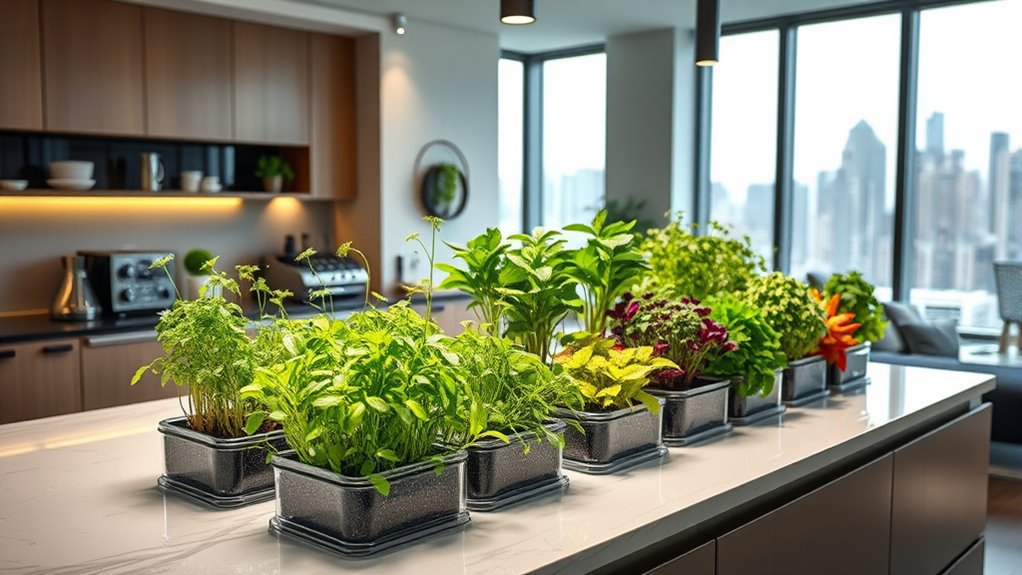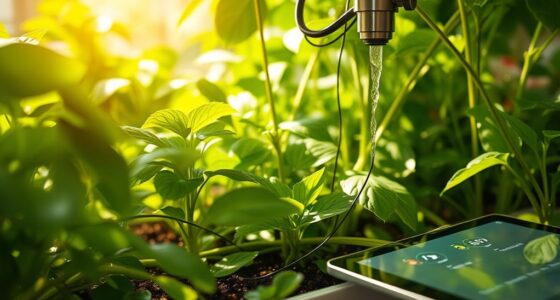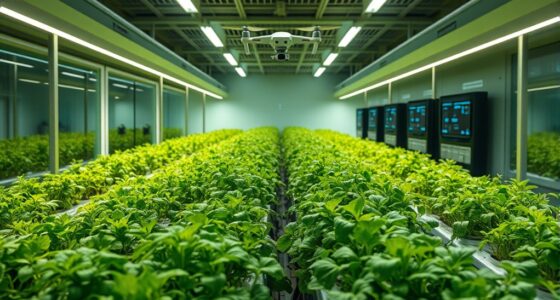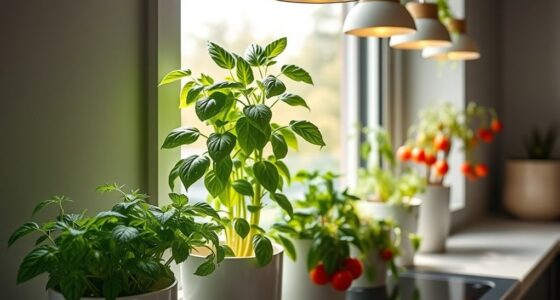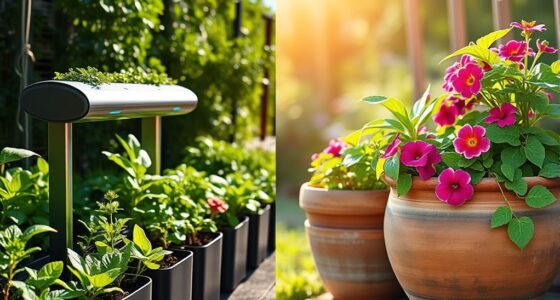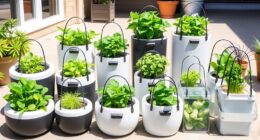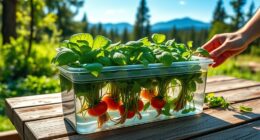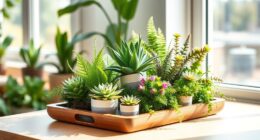The smart indoor garden revolution lets you grow fresh herbs and vegetables right on your countertop using compact, high-tech farms. These devices use advanced LED lights, automated watering, and environmental controls to maximize space and make gardening easy, even in small urban homes. They boost food security, reduce environmental impact, and bring a touch of nature indoors. To discover how these innovative farms can transform your lifestyle, explore further details below.
Key Takeaways
- Countertop farms maximize limited urban space with vertical, multi-tier designs for growing herbs, vegetables, and greens indoors.
- Advanced features like LED grow lights, automated watering, and app control make indoor farming accessible and low-maintenance.
- These devices promote sustainable living by reducing food miles, water use, and chemical reliance through efficient technology.
- Indoor gardens enhance urban food security by providing year-round fresh produce and reducing dependence on external supply chains.
- Innovations like AI, IoT, and sensor integration are driving smarter, more efficient indoor farming systems for city living.
The Rise of Compact Farming Devices in Urban Homes
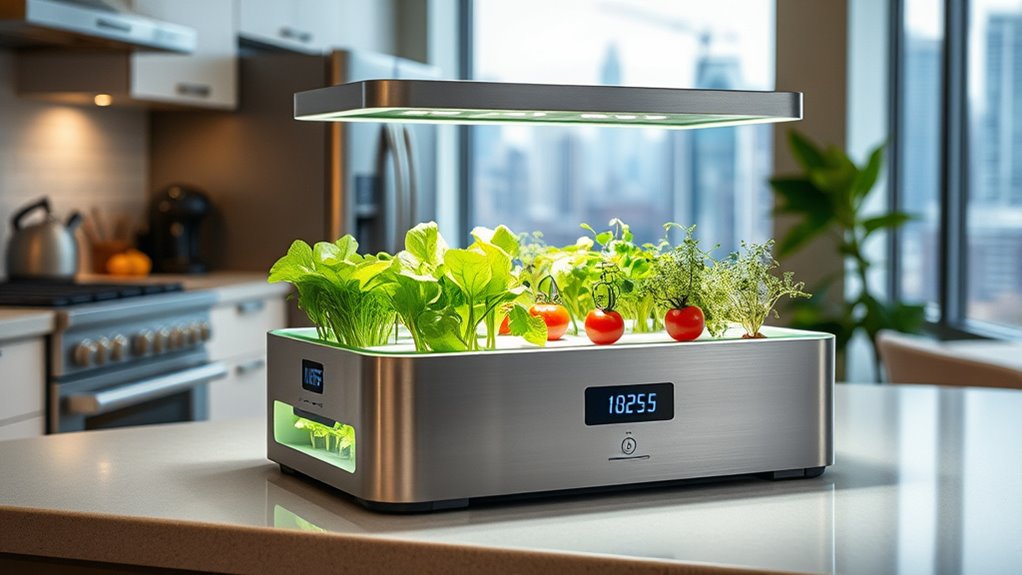
As urban living spaces become smaller, more people are turning to compact farming devices to grow their own herbs, vegetables, and greens indoors. These devices seamlessly blend into urban aesthetics, offering a sleek, modern look that enhances your home decor. They’re designed to maximize limited space while providing fresh produce year-round. When considering cost comparison, compact farming devices often prove more economical than frequent grocery store trips or outdoor garden setups in small yards. They require less water, electricity, and maintenance, making them an efficient choice for city dwellers. Plus, their user-friendly features mean you can easily cultivate your own herbs and greens without a green thumb. This rise in indoor farming devices demonstrates a practical, stylish solution for urban residents wanting fresh food at their fingertips. Creating your own greenhouse can be an accessible extension of these indoor systems, enabling even more control over your gardening environment.
Key Technologies Powering Smart Indoor Gardens
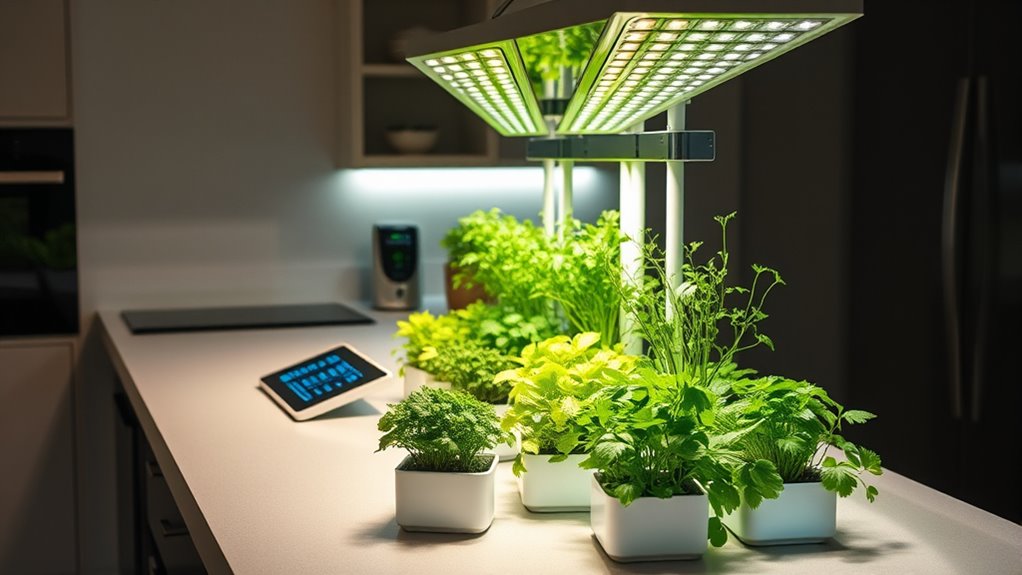
You’ll find that automated nutrient delivery systems keep your plants healthy without constant fuss, ensuring they get the right nourishment at the right time. LED grow lighting systems mimic natural sunlight, helping your indoor garden thrive regardless of outside conditions. Together, these technologies make maintaining a lush indoor garden easier and more efficient. Additionally, precision spray tips enhance watering accuracy, preventing over- or under-feeding your plants.
Automated Nutrient Delivery
Have you ever wondered how smart indoor gardens guarantee plants receive the right nutrients at the right time? Automated nutrient delivery systems make this possible by precisely monitoring and adjusting nutrient levels to maximize soil health. These systems use sensors to track pH, moisture, and nutrient concentration, ensuring plants get exactly what they need without over- or under-fertilizing. By maintaining ideal soil conditions, they also help reduce pest problems linked to poor soil health. Automation minimizes the risk of contamination and pest attraction, supporting healthier growth without the need for chemical pest control. This technology simplifies garden management, keeping your plants thriving while promoting sustainable practices. With automated nutrient delivery, your indoor garden becomes more efficient, resilient, and easier to care for. Additionally, integrating technological solutions can further enhance the overall productivity and sustainability of your indoor garden.
LED Grow Lighting Systems
LED grow lighting systems are the powerhouse behind efficient and customizable indoor gardens. They provide the ideal spectrum of light needed for healthy plant growth, making them essential for supporting plant-based diets and enhancing gardening aesthetics. With adjustable brightness and color options, you can tailor the light to suit different plants and growth stages. Plus, LED systems are energy-efficient, last longer, and generate less heat, helping you maintain a comfortable indoor environment. Here’s what makes them special:
- Customizable light spectrums for various plants
- Energy-efficient and cost-effective operation
- Reduced heat output, protecting delicate plants
- Support for year-round gardening, regardless of season
These features empower you to grow fresh produce and beautiful greenery effortlessly indoors. Incorporating color temperature adjustments can further optimize your lighting setup for specific plant needs.
Benefits of Growing Food Indoors in Small Spaces

Growing food indoors in small spaces helps you maximize every inch of available area, making it easier to produce fresh produce without needing a large garden. You’ll enjoy access to nutrient-rich, farm-fresh foods right at home, ensuring better flavor and health benefits. This approach makes healthy eating more convenient and sustainable, even in limited spaces. Incorporating natural materials and rustic decor can enhance the ambiance of your indoor garden setup, creating a cozy and inviting environment.
Space Efficiency Gains
Indoor gardening maximizes limited space by allowing you to cultivate a variety of crops vertically and in compact setups. With vertical stacking and multi tier systems, you can grow more plants in a small area, making efficient use of every inch. This setup is perfect for urban environments where space is at a premium. You can optimize your countertop or shelf space by layering plants, reducing clutter and increasing productivity. Plus, multi tier systems enable you to grow herbs, leafy greens, and small vegetables simultaneously. It’s like creating a mini farm within your home, boosting your harvest potential without expanding your footprint. Additionally, understanding fandom’s past, present, and future can help you tailor your indoor garden to meet evolving preferences and trends. Whether you have a tiny apartment or a cozy kitchen, these space-saving methods turn limited space into a thriving indoor garden.
Freshness and Nutrition
Because fresh, nutritious produce is essential for a healthy diet, growing your own food indoors guarantees you have access to peak flavor and quality. With proper harvesting techniques, you can pick vegetables and herbs at their ideal ripeness, maximizing freshness and nutritional value. Indoor gardens often allow you to harvest more frequently, ensuring your produce stays at its flavor peak. Additionally, growing indoors reduces exposure to pesticides and contaminants, preserving the natural nutrients. The controlled environment also enhances flavor, making your herbs and greens more vibrant and aromatic. By mastering simple harvesting techniques, you guarantee every bite delivers maximum nutrition and flavor. This direct approach to growing food keeps your diet wholesome while elevating the taste experience right from your countertop.
Popular Types of Countertop Farms and Their Features
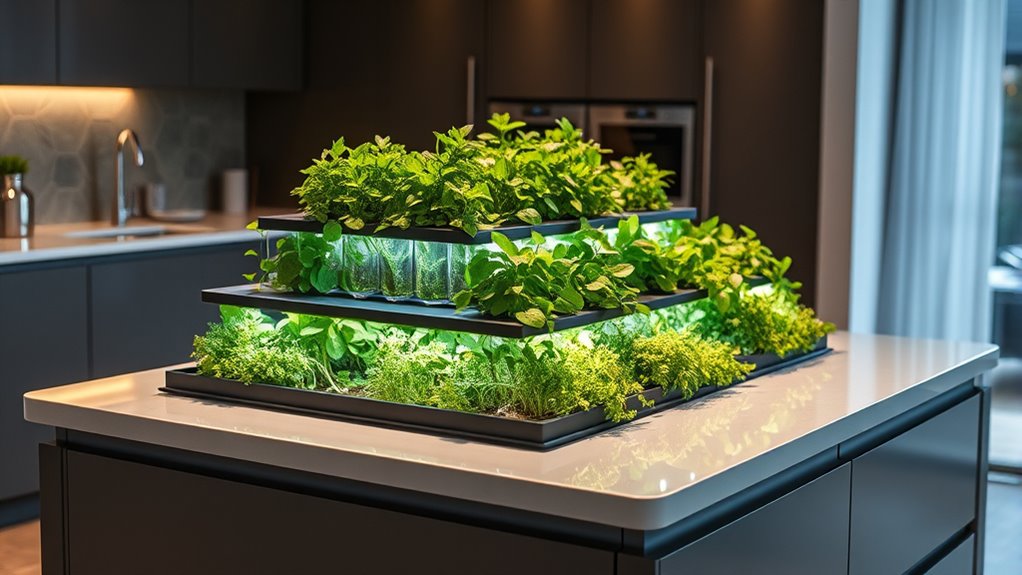
Countertop farms have become a popular choice for home gardeners looking to maximize space and fresh produce. These compact setups come in various types, each with unique features. Hydroponic systems use nutrient-rich water to grow plants without soil, making them efficient and low-maintenance. Aeroponic farms suspend roots in air, delivering nutrients through mist, which promotes faster growth. Some farms incorporate LED grow lights to optimize light exposure. Others feature automatic watering and climate controls for ease of use. A few models even include app connectivity for remote monitoring. Whether you prefer the soil-free precision of hydroponics or the innovative approach of aeroponics, there’s a countertop farm suited to your space and lifestyle. These options make indoor gardening simple, productive, and accessible. Vetted Top 15 options for convenience are available to suit different needs and preferences.
Tips for Setting Up and Maintaining Your Indoor Garden

Setting up your indoor garden begins with choosing the right location—ideally a spot with ample light, good airflow, and easy access for maintenance. Plan your garden layout to maximize space and ensure each plant has enough room to grow. Keep taller plants toward the back and shorter ones in front for easy care. Regularly inspect your garden for pests; early detection makes pest control simpler and prevents infestations. Use natural methods like neem oil or introducing beneficial insects to keep pests at bay without chemicals. Maintain consistent watering and monitor humidity levels to promote healthy growth. Proper lighting, ventilation, and organized layout help prevent problems and make maintenance straightforward. Additionally, ensuring your grow lights provide sufficient light quality can significantly boost plant health and productivity. With these tips, your indoor garden will thrive, providing fresh produce and a lush indoor oasis.
Environmental Impact and Sustainability Aspects

Indoor gardening offers a sustainable alternative to traditional agriculture by reducing the need for transportation and minimizing land use. This approach helps lower your carbon footprint and promotes resource conservation. By growing food indoors, you save water and energy typically used in large-scale farming. Additionally, these gardens:
Indoor gardening reduces environmental impact by conserving resources and lowering carbon footprints.
- Use LED grow lights that consume less electricity
- Require minimal water through efficient recirculation systems
- Eliminate the need for pesticides and chemicals
- Reduce food waste by harvesting only what you need
- Incorporate vetted electric bike conversion kits for eco-friendly transportation of supplies and produce
This sustainable setup not only cuts down on environmental impact but also encourages mindful resource use. With less reliance on land and fewer emissions, your indoor garden supports a greener, more eco-friendly lifestyle.
How These Gardens Are Influencing Urban Food Security
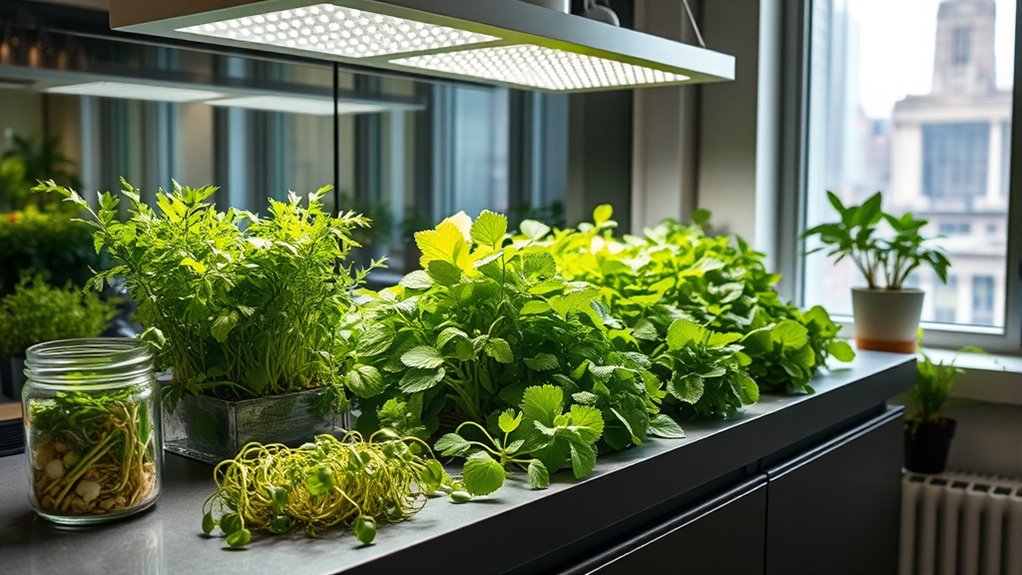
Have you noticed how indoor gardens are reshaping urban food security? These innovative farms bring fresh produce directly into city environments, reducing reliance on long supply chains. By growing food at home or in local community spaces, you help boost urban food sovereignty, giving residents more control over what they eat. This shift fosters community resilience, as neighborhoods become less dependent on external food sources and more capable of supporting themselves during disruptions. Indoor gardens also promote year-round harvests, ensuring consistent access to nutritious vegetables and herbs. As a result, cities become more self-sufficient and adaptable to changing conditions. Emerging technologies like smart IoT systems enhance plant care efficiency and yields, further supporting urban food security. You play a crucial role in strengthening urban food security, making neighborhoods healthier, more sustainable, and better prepared for future challenges.
Future Trends and Innovations in Indoor Farming
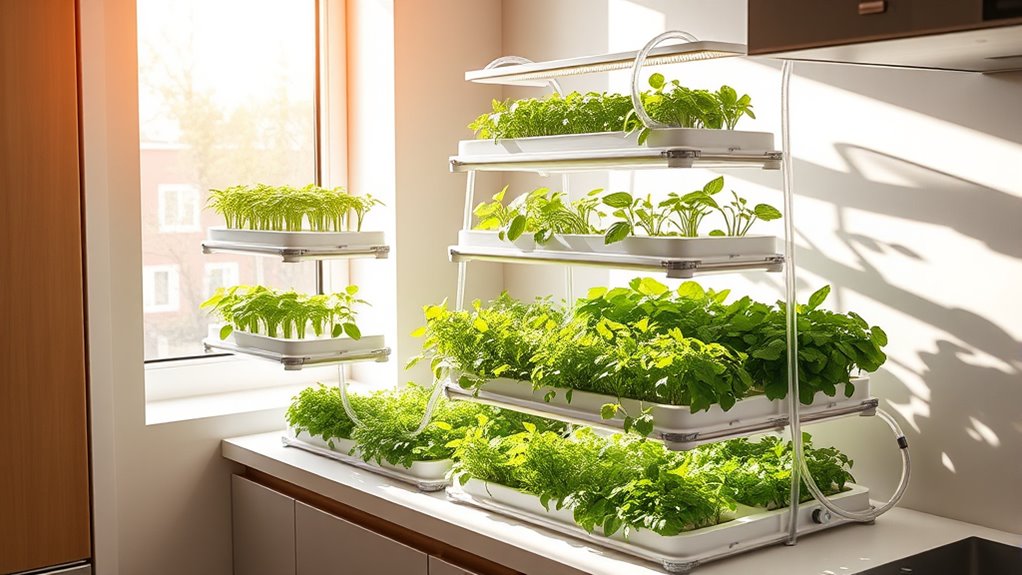
As technology advances, indoor farming is poised to become even more innovative and efficient. Expect smarter hydroponic systems that optimize water use and nutrient delivery with minimal input. Innovations in plant signaling will allow your indoor gardens to communicate needs like light, water, or nutrients, creating more resilient crops. Future trends include AI-driven automation, which adjusts conditions in real-time for maximum growth. Additionally, sensor technology will monitor plant health and soil or water quality, alerting you to issues before they escalate. Automation technology will also enable more precise control over environmental factors, further enhancing crop yields. Vertical farming will expand, making better use of limited space. These developments will make indoor gardens easier to maintain and more productive, empowering you to grow fresh food with less effort and greater precision.
Frequently Asked Questions
How Do Countertop Farms Compare in Cost to Traditional Gardening?
Countertop farms often have a higher initial investment than traditional gardening, but they excel in cost efficiency over time. You save on soil, water, and pest control, reducing ongoing expenses. While traditional gardening may be cheaper upfront, countertop farms offer convenience and consistent yields, making them a smarter long-term choice. Your investment pays off with fresh produce year-round, especially in urban settings where space and resources are limited.
Are Indoor Gardens Safe for Children and Pets?
Imagine a tiny jungle in your kitchen—bright, lively, full of promise. You wonder if indoor gardens are safe for children and pets. Rest assured, with child safety and pet safety in mind, many models use non-toxic materials and secure designs. Keep an eye on your little explorers, and you’ll enjoy fresh herbs worry-free. Proper placement and supervision turn your indoor farm into a safe, green sanctuary for all.
Can These Devices Grow a Variety of Herbs and Vegetables?
You can definitely grow a variety of herbs and vegetables with these devices. They support a broad herb variety, including basil, mint, and cilantro, and offer many vegetable options like cherry tomatoes and lettuce. These countertop farms make it easy to cultivate fresh produce year-round, even in small spaces. With adjustable lighting and automated watering, you’ll enjoy a diverse harvest that keeps your meals flavorful and healthy.
What Maintenance Is Required to Keep Indoor Gardens Healthy?
To keep your indoor garden healthy, you should regularly monitor pest control and establish consistent watering routines. Check for pests and remove any signs of infestation promptly. Water your plants as needed, avoiding overwatering or underwatering. Clean the containers and light fixtures periodically to prevent mold and disease. Proper care, including pest control and watering routines, guarantees your indoor garden thrives and provides fresh herbs and vegetables effortlessly.
Do Smart Indoor Gardens Use Significant Energy Resources?
Ever wondered if your smart indoor garden guzzles energy? It’s true, these systems do consume some energy, mainly for lighting and climate control. However, their overall energy consumption is usually low compared to traditional farming methods, resulting in a smaller environmental impact. By choosing energy-efficient models, you can enjoy fresh herbs and veggies without worrying about excessive energy use, making your garden both smart and eco-friendly.
Conclusion
With over 50% of the world’s population living in cities, smart indoor gardens are transforming urban living. These compact farms not only provide fresh produce but also reduce food miles and waste. As technology advances, expect even smarter, more efficient systems to emerge. If you’re considering joining this revolution, know that you’re helping to build a more sustainable, secure food future—one countertop at a time.
